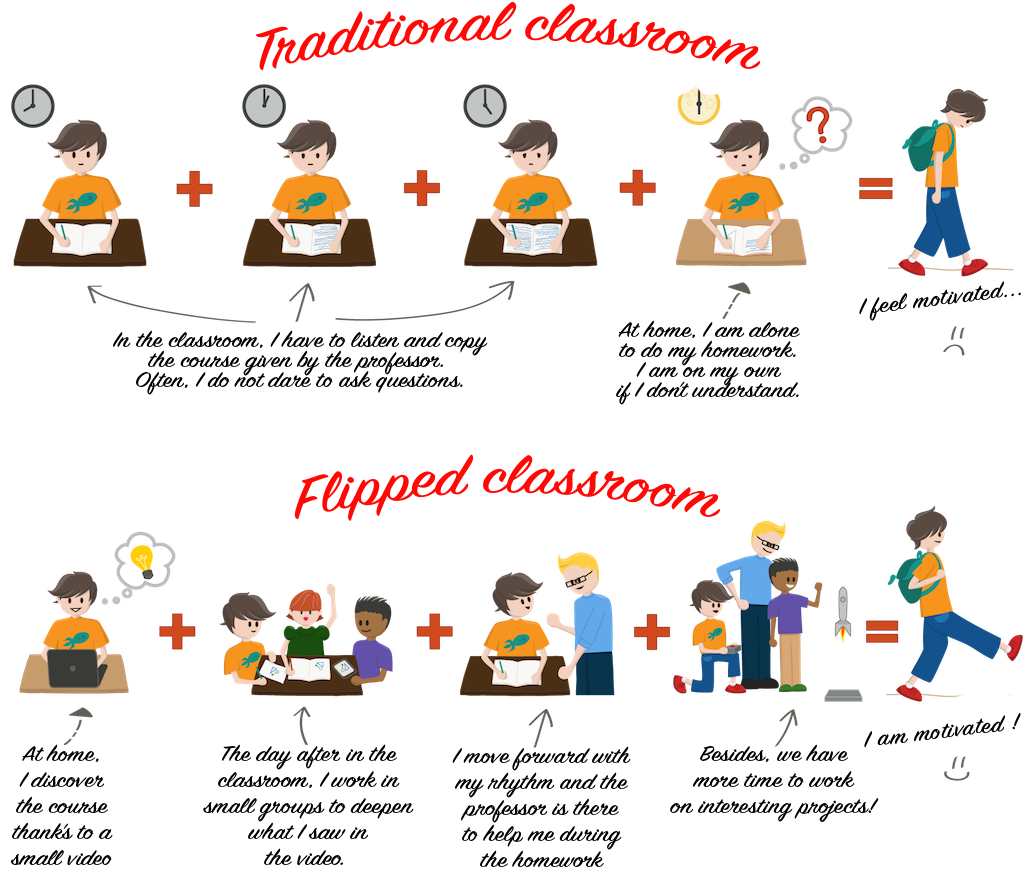1. The flipped classroom
The flipped classroom is an instructional strategy that reverses the traditional learning environment by delivering instructional content outside of the classroom. It moves activities, including those that may have traditionally been considered as homework, into the classroom :

The work is divided in 4 phases :
- Phase A : I discover a new concept before the course
The students discover the new notions which will be then worked in class. They have to look at the small video, take some notes and answer very simple questions: all the answers to the questions are in the video!
– - Phase B : I develop further this new concept by collaborating with the other students during the course
The students all work in groups, they research, they experiment, they dig their brains, etc…. The purpose? Deepen the notions that they saw in the video.
– - Phase C : I retain the most important notions.
The students formalize their discoveries by writing the course: it is what they have to know at the end of the session.
– - Phase D : I train myself by making exercises during the course (the homework).
The students make exercises to train. They make the exercises alone, and when they do not find they can be helped by others (learning by the peers) or by the professor. Those exercices are the homework, except that they are made in class.
–
A video with explanations (in french) :
Only the phase A must be done at home. It takes from 5 to 10 minutes of personal work per week.
2. Adaptative dimension
In the classroom, the students work at their rhythm and collaborate in small groups to deepen their knowledge. The students who met difficulties work with the professor in a step by step mode.
The students who ended the work pass in autonomy and work on a project ‘Fil rouge’. They have to finish this project at the end of the year. Feel free to ask your child in order to explain you what this ‘Fil rouge’ project is.
- Classic pedagogy : All the students must learn at the same rhythm.
- Adaptative dimension : Each student can learn at is own rhythm.
3. Notes and grades, every quarter
In Pronote, you’ll see different notes :
– Some notes about the questions they have to answer to, after seeing the video at home.
Every time the homework are not done, they have 0/5.
– Some notes about evaluations (Coefficient 2 in case of individual evaluation – coefficient 1 in case of group evaluation)
– Some notes about the projet fil rouge (coefficient 1 at the first trimester and Bonus coefficient 1 for the final projet)
– One note per quarter about work and rules respect (coefficient 0.5), see paragraph 5
4. Work evaluation
I practise the positive and by skills evaluation.
As soon as we begin a new theme, the students know the objectives of knowledge and skills which they will have to have acquired at the end of the theme. They know in advance all that they will have to master to succeed in the evaluation.
When I correct the evaluation, I do not put a note but I confirm every skill or knowledge according to 4 levels:
- GREEN-GREEN : I widely reached the goal straight off
- GREEN : I reached the goal in spite of some imperfections
- RED : I did not reach the goal but I am close to succeed
- RED-RED : I have to start from scratch concerning this objective
How does it work ?
- Week 1 : All the students must pass the evaluation.
– - Week 2 : I return the corrected evaluations, and the students redo in groups the exercises which raised most problems. They help each others, those who succeeded explain to the others and I take care of students most in difficulties.
– - Week 3 : If an objective has not been reached (RED or RED-RED), the student will be evaluated a second time on this objective. A second chance to succeed.
Finally, an accessible converter here allows to transform these 4 levels into note. You’ll find this note on Pronote.
A video with explanations (in french) :
5. The Bruitomètre
During the course, all the exchanges between the teacher and the students, but also between the students must be realized only in French.The more they will practise the French language, the more they will enrich their vocabulary and thus more they will feel at ease, in particular for the exams they’ll have.
Besides, as the students work all the time in groups, they have to work peacefully. I use a very simple system who allows them at any time to know how is the class about the noise level and the French atmosphere : The Bruitomètre.

In the classroom, the students are alternately all in charge of the management of the Bruitomètre.
According to the shown color (from green to red), the fil rouge project note of all the students of the class will be either increased or decreased in 10 or 20 % at the end of quarter. To have a 20 % increased note, the students have to work peacefully in French. You’ll also find this note on Pronote at the end of each quarter.
–
6. change the classroom’s rules ?
The students can also change the rules and the way the class is functioning.
How is it possible ? All the explanations are here (in french).
